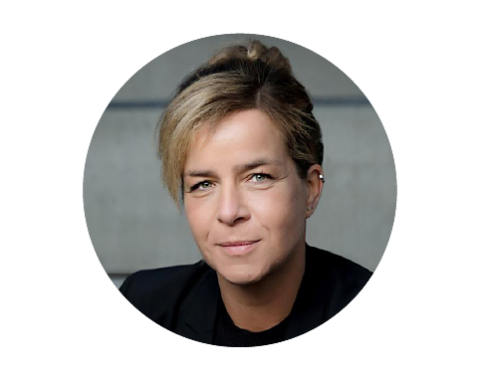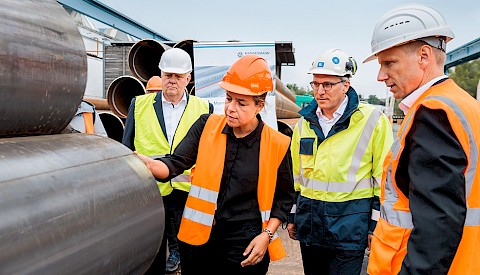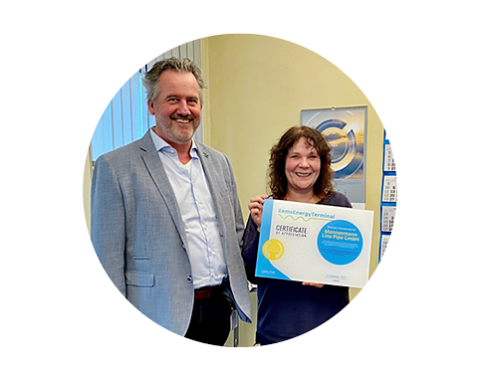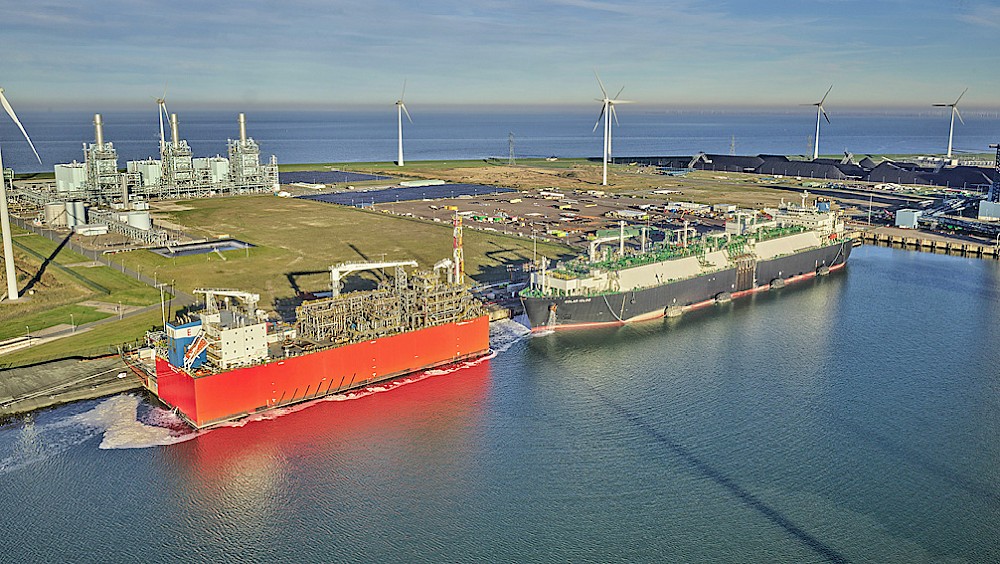LNG terminals – vital for security of supply in Germany and Europe
So that Germany and Europe have a reliable supply of energy without being dependent on Russia, the
development of LNG infrastructure will be all-important. Mannesmann Line Pipe has supplied HFI-welded steel pipes to no fewer than three projects within a very short space of time, opening up long-term prospects for the transition from LNG to green gases.
Germany and Europe wish to end their dependence on Russian gas supplies as quickly as possible. In Germany alone, around 50 billion cubic meters of gas will have to be substituted each year. The development of new import infrastructure is therefore of central importance. In the short term, so-called FSRUs (Floating Storage and Regasification Units) will be essential for deliveries of LNG by ship. FSRUs are in most cases chartered ships equipped with the appropriate equipment to convert liquefied natural gas back into its gaseous state.
In March 2023, a total of 48 LNG terminals were in operation in Europe, with 49 more in development.
Quality and speed of the essence
Mannesmann Line Pipe has served no fewer than three projects at short notice: the German LNG terminals in Wilhelmshaven and Brunsbüttel, and Eemshaven in the Netherlands.
The decisive factors for awarding the contract to Mannesmann Line Pipe were its consultancy skills, product quality and rapid availability, as well as the possibility of supplying hydrogen and ammonia in the longer term.
Mona Neubaur, Deputy Minister President of North-Rhine/Westphalia, also wanted to see this capability for herself. On 5 August 2022, she visited the Mannesmann Line Pipe plant in Hamm and had Managing Director Andreas Betzler explain the HFI welding process to her in detail. Afterwards, she said: "Today it has once again become clear that technical expertise from North Rhine-Westphalia is in greater demand than ever and indispensable for the huge challenges of the energy and climate transition. With steel pipes made in NRW, the Mannesmann Line Pipe plant is contributing significantly not only to the rapid construction of the LNG terminal in Wilhelmshaven, but also to the security of gas supplies throughout Germany."
Also present was Holger Kreetz, COO Asset Management of the LNG terminal operator Uniper. When asked about the extremely tight schedule, he added: "This is precisely why it is important to have dependable partners like Mannesmann Line Pipe GmbH, supporting us with the necessary pragmatism and expertise."
With steel pipes made in NRW, the Mannesmann Line Pipe plant is contributing significantly not only to the rapid construction of the LNG terminal in Wilhelmshaven, but also to the security of gas supplies throughout Germany.«Mona Neubaur, Minister of Economic Affairs, Industry, Climate Action and Energy and Deputy Minister President of North-Rhine/Westphalia

Foto: © MWIKE NRW/Nils Leon Brauer

Minister Mona Neubaur inspects HFI-welded steel pipes as used for connection to the natural gas pipeline network at the LNG terminal in Wilhelmshaven (from the left):
Jürgen Olbrich, Buhlmann; Minister Mona Neubaur, Holger Kreetz, Uniper; and Andreas Betzler, Mannesmann Line Pipe
Wilhelmshaven LNG terminal – independent of the tides
As the only deep-water port in Germany, Wilhelmshaven offers the ideal conditions for the first FSRU at the LNG terminal. Building on the existing infrastructure at the Voslapper Groden transhipment facility, the project was executed at high speed thanks to the LNG Acceleration Act.
Mannesmann Line Pipe wasted no time in producing the urgently needed pipes for the 3.3 km long high-pressure gas pipeline connecting the Wilhelmshaven LNG terminal to the transfer point of Open Grid Europe, the transmission system operator.
The 230 HFI-welded steel pipes with a diameter of 610 x 16 mm were given
a special coating on the outside for improved UV and saltwater resistance and delivered to the construction site just in time in a total of 32 truckloads.
Even before Christmas 2022, regasified liquefied natural gas was flowing
at a record rate into the German long-distance gas grid via Wilhelmshaven. Initially, this will meet 6 per cent of Germany's gas needs and compensate
for around 11per cent of German gas imports from Russia.
Next step "Green Wilhelmshaven"
In the second project step, a permanent and extended port solution for the FSRU is to be realised in parallel to the floating transhipment facility. The plan is to create additional unloading and transhipment facilities for green gases, e.g. hydrogen and ammonia, so as to fully exploit the potential of this new infrastructure project.
Brunsbüttel LNG terminal
Schleswig-Holstein's largest continuous industrial and port location is strategically located where the Kiel Canal meets the Elbe. Even the largest tankers with up to 266,000 cubic meters of LNG on board can dock here. This equates to almost 160 million cubic meters of pipeline gas per delivery. Twelve such tankers would be sufficient to supply Hamburg with natural gas for a year.
To integrate the initial volumes from the floating terminal at short notice, Gasunie constructed a roughly 3.5 kilometer high-pressure gas pipeline in December 2022 that feeds into the Schleswig Holstein Netz regional grid. For this, Mannesmann Line Pipe supplied 587 tonnes of HFI-welded steel pipes with a diameter of 610 mm. The pipes were given an epoxy flow lining and an external special coating for improved UV and saltwater resistance. Following the successful commissioning of the pipeline, the Höegh Gannet docked at the Elbe port in Brunsbüttel in January 2023. Since then, the German long-distance natural gas grid has also been supplied with regasified LNG from here.
So that the Brunsbüttel capacity with an annual output of 7.5 billion cubic meters becomes fully available to consumers in Germany and neighboring European countries in the medium term, Gasunie is building its Energy Transmission Line (ETL) 180, an approximately 55 km long pipeline to Hetlingen (Pinneberg district).

The LNG terminal in Wilhelmshaven was completed at high speed. LNG in regasified form was already being fed via this terminal into the German long-distance natural gas pipeline network in December 2022. Photo: © N Ports, Wolfhard Scheer

German LNG Terminal GmbH is planning to build a multifunctional LNG terminal in Brunsbüttel. The terminal is scheduled to go into operation by the end of 2026. It will initially facilitate the import of LNG, then increasingly process "green" natural gas and later probably import hydrogen derivatives.
Visualisation: © RWE/German LNG Terminal GmbH
H2 Brunsbüttel
Brunsbüttel is an important location as a technology and industrial center, and also for imported green energy sources in the longer term. It is already obvious that domestic production will not be able to meet the anticipated future demand for hydrogen. RWE is therefore building an import terminal for green ammonia, at which some 300,000 tonnes of green ammonia are to be imported annually from 2026. German LNG Terminal GmbH also plans to build and operate a multifunctional LNG terminal in the immediate vicinity.
EemsEnergyTerminal awarded the Langman Prize in 2022
Also completed in record time, the LNG terminal in Eemshaven in the Netherlands has been in operation since 15 September 2022 after just six months for construction. It consists of two FSRUs, each chartered for five years. The terminal's capacity of around 8 billion cubic meters of natural gas per year has been fully utilised since March 2023. This can be gradually increased to 10 billion cubic meters of gas per year going forward.
For their huge commitment and rapid project execution, several organisations were awarded the Langman Prize. This is presented annually at a New Year's reception and is an initiative of the Northern Netherlands Alliance. It is awarded to a person or organisation that goes beyond the bounds of conventional thinking, action, management and problem solving, thereby promoting social or economic development in the north of the Netherlands.
Confirmation of the H2ready® strategy
Mannesmann Line Pipe has supplied some 550 tonnes of HFI-welded steel pipes for an almost 4 km long pipeline to link up the LNG terminal in Eemshaven. Mannesmann Line Pipe has been commended by the terminal operator Gasunie for the production of the pipes to demanding customer specifications under high deadline pressure and for the rapid loading and delivery of the pipes. Regional Sales Manager Monika Langenbach and Sales Manager Konrad Thannbichler personally accepted the certificate from Erik Habing, Senior Purchase & Contract Manager, in Siegen on 26 January 2023.
Thannbichler took the opportunity to give his interim verdict on LNG terminals: "We are naturally proud to be commended as a supplier to such important infrastructure projects. When we hear from our clients that the LNG terminals should be designed to handle hydrogen in the medium to long term, we believe we are in an excellent position with our H2ready® products. Our products not only contribute significantly to security of supply in Germany and Europe, but are already paving the way for the transition from LNG to green gases."

Erik Habing, Gasunie, presented the supplier award for the EemsEnergyTerminal project to Sales Area Manager Monika Langenbach.
LNG – liquefied natural gas for Germany and Europe

The EemsEnergyTerminal in Eemshaven was commissioned within six months.
Photo: © EemsEnergyTerminal
In principle, LNG is nothing more than highly compressed natural gas. This liquefies it and reduces its volume by a factor of around six hundred. This makes the process economically viable for transport by ship, even over long distances. However, natural gas only liquefies at around minus 162 degrees Celsius. Liquefaction, transport and reprocessing are therefore energy-intensive and technically highly demanding.
To safeguard supplies in the short term, Germany resorts to special ships known as Floating Storage and Regasification Units (FSRU). The ships take the liquefied natural gas from tankers and convert it on board into gas.
For onward transport, a pipeline connection to the mainland is required in each case. At transfer stations the regasified LNG can then be fed into the long-distance gas network or stored in one of the numerous German natural gas storage facilities.
The FSRUs are to be replaced in the medium term by facilities close to the port so that regasification can take place on land.
In the long term, the facilities are also designed to process hydrogen and hydrogen derivatives so they can play a key role in the energy transition.
